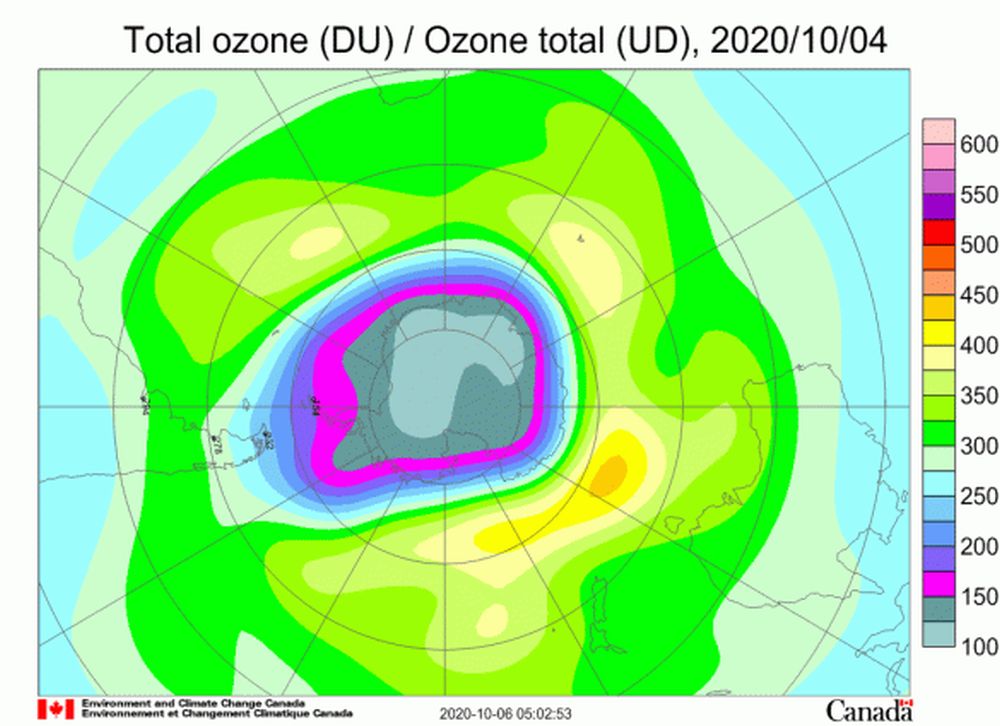Ozone Hole over Antarctic Has Reached its Largest in 2020
Over the years, the ozone layer has suffered profoundly at the hands of humankind. The protective layer that envelops the earth and repels the harmful sun rays has been depleting for quite some time now. There are many holes in the layer, the biggest of them being the one over the Antarctic, which was first spotted in 1985.
Every year in August at the start of the Antarctic Spring, the ozone hole begins to grow and reaches its peak by the month of October. According to the World Meteorological Organization (WMO), this hole has reached its peak in 2020. The finding is based on observations by the European Union’s Copernicus Atmospheric Monitoring Service (CAMS).

Image: NASA
WMO’s Global Atmosphere Watch Programme works closely with CAMS, NASA, and Environment and Climate Change Canada and other partners to monitor the ozone layer protecting the earth. After Montreal Protocol banning the use of ozone-depleting chemicals, the ozone was finally on a path to recovery, but the fluctuating temperatures and changing climatic conditions of the earth have increased the size of the hole even further.
The #ozone hole over the #Antarctic is one of the largest and deepest in recent years, per @CopernicusECMWF, @NASAEarth, @environmentca and WMO’s Global Atmosphere Watch network.
Analyses show the hole has reached its maximum size for the year.
Details https://t.co/QjU9BqIhcZ pic.twitter.com/dc4dGQK4rA— World Meteorological Organization (@WMO) October 6, 2020
Reportedly, in 2020, the ozone hole grew rapidly from mid-August and peaked at around 24 million square kilometers in early October. NASA’s Ozone Watch has reported that on October 1, the lowest value of 95 Dobson units was recorded.
The 2020 ozone hole resembles the one from 2018, which also was a quite large hole, and is definitely in the upper part of the pack of the last fifteen years or so…With the sunlight returning to the South Pole in the last weeks, we saw continued ozone depletion over the area. After the unusually small and short-lived ozone hole in 2019, which was driven by special meteorological conditions, we are registering a rather large one again this year, which confirms that we need to continue enforcing the Montreal Protocol banning emissions of ozone depleting chemicals.
said Vincent-Henri Peuch, Director of CAMS.
Scientists believe that the large ozone hole in 2020 has been driven by a strong, stable and cold polar vortex that kept the temperature of the layer over the Antarctic constantly cold. Apparently, ozone depletion is directly related to the temperature in the stratosphere; as polar stratospheric clouds that play an important role in the chemical destruction of ozone, only form at temperatures below -78 degrees Celsius.
These polar stratospheric clouds contain ice crystals that can transform non-reactive compounds into reactive ones, leading to the rapid destruction of ozone molecules as soon as sunlight reaches them to begin the chemical reactions.

Image: Environment and Climate Change Canada
If the temperature instability remains consistent, the ozone layer could keep depleting to more harmful levels. Following the Montreal Protocol to its entirety may be the only option to save the protective layer from further damage.


